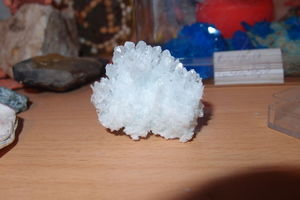Ammonium chloride
 |
This article is a stub. Please help Sciencemadness Wiki by expanding it, adding pictures, and improving existing text.
|
 Lab grown crystals of ammonium chloride from Crystal grower's collection.
| |
| Names | |
|---|---|
| IUPAC name
Ammonium chloride
| |
| Systematic IUPAC name
Ammonium chloride | |
| Other names
Sal ammoniac
Salmiac | |
| Identifiers | |
| Jmol-3D images | Image |
| |
| Properties | |
| NH4Cl | |
| Molar mass | 53.49 g/mol |
| Appearance | White solid |
| Odor | Odorless |
| Density | 1.5274 g/cm3 |
| Melting point | 338 °C (640 °F; 611 K) (sublimes) |
| Boiling point | 520 °C (968 °F; 793 K) (decomposition) |
| 24.4 g/100 ml (−15 °C) 29.4 g/100 ml (0 °C) 38.3 g/100 ml (25 °C) 45.44 g/100 ml (40 °C) 74.08 g/100 ml (100 °C) | |
| Solubility | Soluble in alcohol, liq. ammonia, glycerol , hydrazine, methanol Slightly soluble in acetone Insoluble in diethyl ether, ethyl acetate, toluene, xylene |
| Solubility in acetic acid | 0.067 g/100 g (16.6 °C) |
| Solubility in ethanol | 0.6 g/100 ml (19 °C) |
| Solubility in glycerol | 9.7 g/100 g |
| Solubility in methanol | 3.2 g/100 g (17 °C) 3.35 g/100 g (19 °C) 3.54 g/100 g (25 °C) |
| Solubility in sulfur dioxide | 0.009 g/100 g (0 °C) 0.0031 g/100 g (25 °C) |
| Thermochemistry | |
| Std molar
entropy (S |
94.56 J·mol-1·K-1 |
| Std enthalpy of
formation (ΔfH |
−314.43 kJ/mol |
| Hazards | |
| Safety data sheet | Sigma-Aldrich |
| Flash point | Non-flammable |
| Lethal dose or concentration (LD, LC): | |
| LD50 (Median dose)
|
1,650 mg/kg (rat, oral) |
| Related compounds | |
| Related compounds
|
Ammonium perchlorate |
| Except where otherwise noted, data are given for materials in their standard state (at 25 °C [77 °F], 100 kPa). | |
| Infobox references | |
Ammonium chloride is an inorganic compound with the formula NH4Cl. It is a white crystalline solid, highly soluble in water. Solutions of ammonium chloride are mildly acidic. Ammonium chloride occurs naturally as mineral Sal ammoniac which is commonly formed on burning coal dumps, due to condensation of coal-derived gases. It is also found around some types of volcanic vents. Ammonium chloride is mainly used as fertilizer and as a flavoring agent in some types of licorice.
Contents
[hide]Properties
Chemical
Ammonium chloride, like all ammonium compounds, will react with bases, such as sodium hydroxide, to give off ammonia gas.
- NH4Cl + NaOH → NH3 + NaCl
Physical
Ammonium chloride is a white crystalline solid, soluble in water.
Availability
Ammonium chloride can be found in many electronic stores, as soldering iron flux. It can also be found in some chimney cleaning products, where it tends to be mixed with other compounds, such as ammonium sulfate. Crystallization or sublimation can be used to extract and purify the compound.
Ammonium chloride can be bought online, from eBay or Amazon.
Lastly, ammonium chloride is sold by various chemical suppliers.
Preparation
Reaction of hydrochloric acid with ammonia will result in ammonium chloride.
- NH3 + HCl → NH4Cl
If the reaction occurs in gaseous phase, a very fine mist of ammonium chloride will form.
Ammonium chloride may be prepared by a precipitation reaction, where an insoluble compound precipitates out, leaving ammonium chloride in solution. An example would be the reaction of calcium chloride with ammonium sulfate:
CaCl2 (aq) + (NH4)2SO4 (aq) → CaSO4 (s) + NH4Cl (aq)
Projects
- Growing crystals
- Making smoke bombs
Handling
Safety
Inhalation: Irritating to mucous membranes. Irritating to respiratory system.
Skin exposure: Repeated or prolonged exposure may cause dermatitis
Ingestion: Harmful if swallowed in large dosages. May cause nausea, vomiting and acidosis. In small dosages it can be consumed without ill effects.
Eyes contact: Irritating to eyes.
Storage
Store in a cool, dry, well ventilated place, in a securely closed original container. Keep it away from bases.
Disposal
Ammonium chloride solution could be poured down the drain or dumped in the trash. While it can be disposed of in the environment as fertilizer, chloride ions are generally harmful to plants, making this salt of ammonium unsuitable to use as a nitrogen source for plants. Can be released in the environment in small quantities, in barren plains, or can also be used to affect weed growth.
References
Relevant Sciencemadness threads
- Article stubs
- Chemical pages without CAS Registry Number
- Articles without EBI source
- Chemical pages without ChemSpiderID
- Chemical pages without DrugBank identifier
- Articles without KEGG source
- Articles without InChI source
- Articles without UNII source
- Articles containing unverified chemical infoboxes
- Chemical compounds
- Inorganic compounds
- Nitrogen compounds
- Ammonium compounds
- Chlorine compounds
- Chlorides
- Halides
- Chemicals for crystal growing
- Readily available chemicals
- Edible chemicals